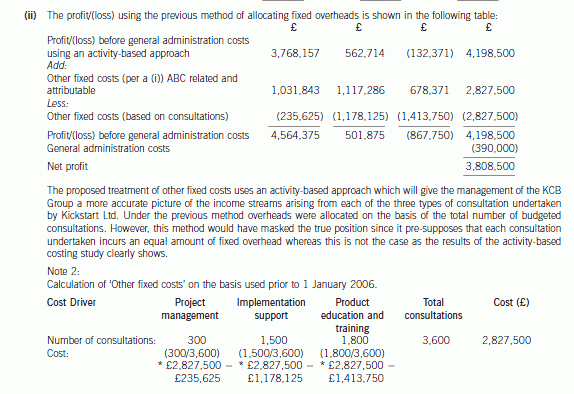新手必看!你想知道的ACCA问题都在这
发布时间:2021-06-03
很多想要备考ACCA考试的考生因为对于ACCA考试不了解从而选择放弃,51题库考试学习网今天为大家带来小白最为关心的问题相关分享,接下来就和51题库考试学习网一起去了解下吧!
(1)在国内从事财务工作是否有必要考ACCA?
如果立志成为一名国际化财务管理人才,那么尽早获得ACCA这样的权威的国际财会专业资格,对于今后的职业发展就显得尤为重要。
第一,积累与实践紧密结合的,国际化的财务管理专业知识和能力,能够迅速进入工作角色。
第二,提高商业敏感度,培养灵活的思维方式。
第三,显著提高财务英语应用水平。
第四,磨练意志力。
(2)ACCA免试的具体条件是什么?
免试范围包括教育部认可高校毕业生、教育部认可高校在校生(本科)和中国注册会计师资格持有人以及其他ACCA认可证书文凭持有人等。这些范围内的人士,ACCA会根据其学历、专业资质等因素进行综合评判予以免考。
(3)ACCA要考几年?一年可以报几次?
ACCA每年有4次考季,每次最多可以报考4门,每年最多报考8门,而ACCA考试全科共需要通过13门考试,建议每次报2-3门考试。学员平均3年左右完成全部考试。
(4)报考ACCA在缴纳费用时有哪些注意事项?
ACCA报名分为3个阶段:提前报名时段,常规报名时段和后期报名时段,报名费用依次增加,在提前报名时段报名是最经济的
(5)ACCA机考报名应该怎么操作?
报名F1、F2、F3机考,需直接联系ACCA认可机考中心报名缴费,这3门科目考试时间灵活,以机考中心安排为准。F5-F9机考,需登录myacca进行在线报考并缴费。
ACCA是目前发展速度最快,海外学员最多的专业会计师组织。在国内也有许多知名院校开始和英国ACCA合资办学考试培训中心,可以参加考试的省份也越来越多,其中考试试卷由英国本土统一阅卷,以确保考试的正规性以及持证人士的专业素养。ACCA证书以科目众多、全英文考试、含金量高等特点保持着很重要的地位。
看过51题库考试学习网给大家带来的相关分享,是不是对于ACCA考试有了基本的认识了,51题库考试学习网在此祝愿广大考生都能取得优异成绩!
下面小编为大家准备了 ACCA考试 的相关考题,供大家学习参考。
3 The managers of Daylon plc are reviewing the company’s investment portfolio. About 15% of the portfolio is represented by a holding of 5,550,000 ordinary shares of Mondglobe plc. The managers are concerned about the effect on portfolio value if the price of Mondglobe’s shares should fall, and are considering selling the shares. Daylon’s investment bank has suggested that the risk of Mondglobe’s shares falling by more than 5% from their current value could be protected against by buying an over the counter option. The investment bank is prepared to sell an appropriate six month option to Daylon for £250,000.
Other information:
(i) The current market price of Mondglobe’s ordinary shares is 360 pence.
(ii) The annual volatility (variance) of Mondglobe’s shares for the last year was 169%.
(iii) The risk free rate is 4% per year.
(iv) No dividend is expected to be paid by Mondglobe during the next six months.
Required:
(a) Evaluate whether or not the price at which the investment bank is willing to sell the option is a fair price.(10 marks)
3 (a) The investment bank is offering to sell to Daylon plc an option to sell Mondglobe ordinary shares at a price no worse than 5% below the current market price of 360 pence. This is a put option on Mondglobe shares at a price of 342 pence. The Black-Scholes option pricing model may be used to estimate whether or not the option price is a fair price. The value of a put option may be found by first estimating the value of a call option and then using the put-call parity theorem.
Basic data:
Share price 360 pence
Exercise price 342 pence
Risk free rate 4% (0·04)
Volatility is measured by the standard deviation. The variance is 169% therefore the standard deviation, σ is 13% (0·13)
The relevant period is six months (0·5)

(b) Identify and explain the financial statement risks to be taken into account in planning the final audit.
(12 marks)
(b) Financial statement risks
Tutorial note: Note the timeframe. Financial statements for the year to 30 June 2006 are draft. Certain misstatements
may therefore exist due to year-end procedures not yet having taken place.
Revenue/(Receivables)
■ Revenue has increased by 11·8% ((161·5 – 144·4)/144·4 × 100). Overstatement could arise if rebates due to customers
have not yet been accounted for in full (as they are calculated in arrears). If rebates have still to be accounted for trade
receivables will be similarly overstated.
Materials expense
■ Materials expense has increased by 17·8% ((88.0 – 74·7)/74·7 × 100). This is more than the increase in revenue. This
could be legitimate (e.g. if fuel costs have increased significantly). However, the increase could indicate misclassification
of:
– revenue expenditure (see fall in other expenses below);
– capital expenditure (e.g. on overhauls or major refurbishment) as revenue;
– finance lease payments as operating lease.
Depreciation/amortisation
■ This has fallen by 10·5% ((8·5 – 9·5)/9·5 × 100). This could be valid (e.g. if Yates has significant assets already fully
depreciated or the asset base is lower since last year’s restructuring). However, there is a risk of understatement if, for
example:
– not all assets have been depreciated (or depreciated at the wrong rates, or only for 11 months of the year);
– cost of non-current assets is understated (e.g. due to failure to recognise capital expenditure)1;
– impairment losses have not been recognised (as compared with the prior year).
Tutorial note: Depreciation on vehicles and transport equipment represents only 7% of cost. If all items were being
depreciated on a straight-line basis over eight years this should be 12·5%. The depreciation on other equipment looks more
reasonable as it amounts to 14% which would be consistent with an average age of vehicles of seven years (i.e. in the middle
of the range 3 – 13 years).
Other expenses
■ These have fallen by 15·5% ((19·6 – 23·2)/23·2 × 100). They may have fallen (e.g. following the restructuring) or may be
understated due to:
– expenses being misclassified as materials expense;
– underestimation of accrued expenses (especially as the financial reporting period has not yet expired).
Intangibles
■ Intangible assets have increased by $1m (16% on the prior year). Although this may only just be material to the
financial statements as a whole (see (a)) this is the net movement, therefore additions could be material.
■ Internally-generated intangibles will be overstated if:
– any of the IAS 38 recognition criteria cannot be demonstrated;
– any impairment in the year has not yet been written off in accordance with IAS 36 ‘Impairment of Assets’.
Tangible assets
■ The net book value of property (at cost) has fallen by 5%, vehicles are virtually unchanged (increased by just 2·5%)
and other equipment (though the least material category) has fallen by 20·4%.
■ Vehicles and equipment may be overstated if:
– disposals have not been recorded;
– depreciation has been undercharged (e.g. not for a whole year);
– impairments have not yet been accounted for.
■ Understatement will arise if finance leases are treated as operating leases.
Receivables
■ Trade receivables have increased by just 2·2% (although sales increased by 11·8%) and may be understated due to a
cutoff error resulting in overstatement of cash receipts.
■ There is a risk of overstatement if sufficient allowances have not been made for the impairment of individually significant
balances and for the remainder assessed on a portfolio or group basis.
Restructuring provision
■ The restructuring provision that was made last year has fallen/been utilised by 10·2%. There is a risk of overstatement
if the provision is underutilised/not needed for the purpose for which it was established.
Finance lease liabilities
■ Although finance lease liabilities have increased (by $1m) there is a greater risk of understatement than overstatement
if leased assets are not recognised on the balance sheet (i.e. capitalised).
■ Disclosure risk arises if the requirements of IAS 17 ‘Leases’ (e.g. in respect of minimum lease payments) are not met.
Trade payables
■ These have increased by only 5·3% compared with the 17·8% increase in materials expense. There is a risk of
understatement as notifications (e.g. suppliers’ invoices) of liabilities outstanding at 30 June 2006 may have still to be
received (the month of June being an unexpired period).
Other (employee) liabilities
■ These may be understated as they have increased by only 7·5% although staff costs have increased by 14%. For
example, balances owing in respect of outstanding holiday entitlements at the year end may not yet be accurately
estimated.
Tutorial note: Credit will be given to other financial statements risks specific to the scenario. For example, ‘time-sensitive
delivery schedules’ might give rise to penalties or claims, that could result in understated provisions or undisclosed
contingent liabilities. Also, given that this is a new audit and the result has changed significantly (from loss to profit) might
suggest a risk of misstatement in the opening balances (and hence comparative information).
1 Tutorial note: This may be unlikely as other expenses have fallen also.
(ii) Using the previous overhead allocation basis (as per note 4), calculate the budgeted profit/(loss)
attributable to each type of service for the year ending 31 December 2006 and comment on the results
obtained using the previous and revised methods of overhead allocation. (5 marks)

(e) Internal controls are very important in a complex civil engineering project such as the Giant Dam Project.
Required:
Describe the difficulties of maintaining sound internal controls in the Giant Dam Project created by working
through sub-contractors. (4 marks)
(e) Control and sub-contractors
Specifically in regard to the maintenance of internal controls when working with sub-contractors, the prominent difficulties
are likely to be in the following areas:
Configuring and co-ordinating the many activities of sub-contractors so as to keep progress on track. This may involve taking
the different cultures of sub-contractor organisations into account.
Loss of direct control over activities as tasks are performed by people outside R&M’s direct employment and hence its
management structure.
Monitoring the quality of work produced by the sub-contractors. Monitoring costs will be incurred and any quality problems
will be potentially costly.
Budget ‘creep’ and cost control. Keeping control of budgets can be a problem in any large civil engineering project (such the
construction of the new Wembley Stadium in the UK) and problems are likely to be made worse when the principal contractor
does not have direct control over all activities.
Time limit over-runs. Many projects (again, such as the new Wembley Stadium, but others also) over-run significantly on time.
Tutorial note: only four difficulties need to be described.
声明:本文内容由互联网用户自发贡献自行上传,本网站不拥有所有权,未作人工编辑处理,也不承担相关法律责任。如果您发现有涉嫌版权的内容,欢迎发送邮件至:contact@51tk.com 进行举报,并提供相关证据,工作人员会在5个工作日内联系你,一经查实,本站将立刻删除涉嫌侵权内容。
- 2020-04-15
- 2020-01-10
- 2020-01-10
- 2020-04-18
- 2020-04-14
- 2020-01-10
- 2020-01-10
- 2020-05-02
- 2020-01-10
- 2020-03-08
- 2020-01-10
- 2020-01-10
- 2020-01-10
- 2020-01-10
- 2020-01-10
- 2020-01-10
- 2020-01-10
- 2020-02-05
- 2020-01-10
- 2020-04-09
- 2020-01-10
- 2020-01-09
- 2020-01-10
- 2020-03-25
- 2020-01-10
- 2020-04-25
- 2020-01-10
- 2020-01-10
- 2020-02-05
- 2020-01-10